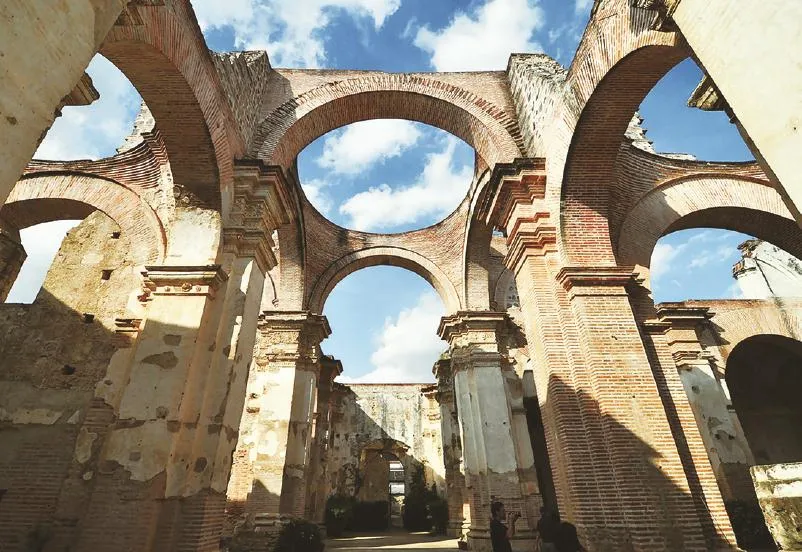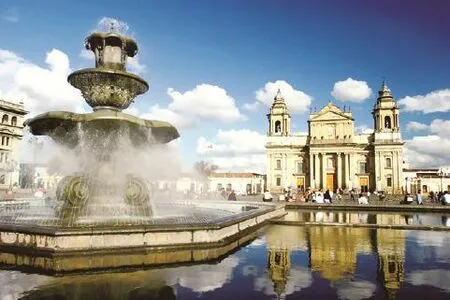A Passport to Guatemala’s Mayan Past
by Polya Lesova
Cass 译
A Passport to Guatemala’s Mayan Past
危地马拉—玛雅不朽
by Polya Lesova
Cass 译



北岛说:“一个人行走的范围,就是他的世界。”所以你毋宁去行走,去跋涉,不为抵达,只为远方。危地马拉是古代玛雅文化的发祥地,素有“森林之国”之称,据说在印第安语里,其意思是“森林茂密的土地”。让我们跟随着本文的作者一起探寻这座不朽的末日之城,领略通往天堂的路上遇见的最美风景!
We were on a motorboat to the past—or so we hoped.
My husband, Paul, and I sat near the bow of the1)skiff, soaking in the sun and the view as we zipped across Lake Atitlán, in Guatemala’s highlands. Several large volcanoes towered in the distance, seemingly standing guard over the villages scattered along the green shores.
Our destination was Santiago Atitlán, the largest town on the lake and a place to encounter the culture of the Tz’utujil—one of roughly 20 Mayan ethnic groups in Guatemala. As we approached the shore, we saw women in traditional purple-striped blouses, waist deep in the water, washing clothes. We walked from the2)ricketypier into town, at frst seeing little more than stalls where locals were aggressively hawking water bottles and maps. But a left turn took us into Santiago Atitlan’s main plaza, which was crowded on market day. Tz’utujil women, some with children, sat on the ground with their wares spread around them: piles of fruits and vegetables, spices, meats. The women wore3)huipiles—striking blouses embroidered with birds and flowers. Some men wore traditional purple-and-white-striped pants, also4)stitchedwith symbols.
Starting around 1500 B.C., the Mayan people established one of the dominant civilizations in5)Mesoamerica. At its height, the empire stretched from southern Mexico to parts of Honduras and El Salvador, with its center in present-day Guatemala. Skilled at agriculture, astronomy and mathematics, the Mayans built stepped stone temples, palaces, and cities that held tens of thousands of residents. But for reasons that are not understood, their civilization went into decline, even before Spanish6)conquistadorsarrived in the early 16th century; urban centers were abandoned to the jungle and many traditions vanished. But not all…
我们正乘坐着摩托艇驶向过去—至少我们怀抱着这样的希望。
我们快速地驶过危地马拉高地的阿蒂特兰湖,我和丈夫保罗坐在小艇的船头沐浴阳光,欣赏美景。远处屹立着几座高耸的火山,俨然守卫着散落在绿色海岸边的村庄。
我们的目的地是圣地亚哥阿蒂特兰镇,那是阿蒂特兰湖上最大的城镇,同时也是邂逅楚图希尔人(危地马拉的大约20个玛雅民族之一)文化的绝佳地点。靠近岸边时,我们看到了身穿传统紫色条纹上衣的妇女们,站在齐腰深的水里,正在洗衣服。我们沿着摇摇晃晃的码头踏进城镇,最先见到的仅仅是几个小摊,本地人正在卖力地兜售水壶和地图。但一个左转弯我们就来到了圣地亚哥阿蒂特兰主广场,在这集市日里显得十分拥挤。楚图希尔妇女们,其中一些带着孩子,坐在地上,身边摆放着她们的商品:一堆堆蔬果、香料和肉。女人们穿着花洋装,引人注目的上衣上绣着鸟类和鲜花。一些男人们穿着传统的紫白色条纹裤子,也刺有一些标志图案。
大约从公元前1500年开始,玛雅人在中美洲建立了世上辉煌的文明之一。在最鼎盛的时期,帝国以今日的危地马拉为中心,从墨西哥南部延伸到洪都拉斯和萨尔瓦多。玛雅人擅长农业、天文学和数学,建造了阶梯式的石头庙宇、宫殿以及容纳了成千上万居民的城市。但是出于不明原因,在16世纪初期,甚至在西班牙征服者来到之前,他们的文明就开始衰落。城市中心被荒废成为丛林,许多的传统习俗也随之湮灭。但并不是一切都消失了……

1) skiff [skɪf] n. 小船
2) rickety [ˑrɪkɪtɪ] adj. 佝偻的;摇摆的
3) huipil [wiːˑpiːl] n. 一种自头部套穿的连衣裙
4) stitch [stɪtʃ] v. 缝,缝合
5) Mesoamerica ['mesəʊəˑmerɪkə] n. 中亚美利加洲,中美洲
6) conquistador [kɒnˑkwɪstədзː] n. 西班牙征服者,征服者
The Maya managed to preserve some of their culture, particularly in Guatemala’s western highlands, which extend from the colonial capital of Antigua, Guatemala to the Mexican border. Earlier this year, Paul and I tried to experience as much of that as possible over a one-week trip, exploring one of the most important ancient sites (now sprawling ruins), as well as communities like Santiago Atitlán.
We started in Antigua, Guatemala, a 16thcentury town just 20 miles from Guatemala City, the modern capital. We spent hours walking the cobblestone streets and taking in the colorful and sometimes ornate colonial architecture. At Jades Imperio Maya, we browsed jewelry made from jade—a prized commodity and good-luck symbol for the ancient Maya, who used it for ornamentation and ceremonial masks. In a workshop at the back of the store, craftsmen shaped stone into objects such as the ring I bought.
For a literal taste of Mayan culture, we took a two-hour class at El Frijol Feliz, a cooking school near Antigua’s central plaza. The instructor spoke only Spanish, so we didn’t understand everything she said, but she taught us how to make pepian, a traditional stew, by boiling pieces of bonein chicken, then adding7)chayote(a vegetable similar to8)squash), roasted chilies, onions, garlic, tomatoes, pumpkin and9)sesameseeds. Rice with vegetables, refried black beans and rellenitos—plantain dumplings filled with black beans and chocolate—were also on the menu. Many of the ingredients we used, such as corn, beans and chilies, have been staples of the Mayan diet for generations.


玛雅人设法保存了他们的一些文化,尤其是在危地马拉西部高地,从危地马拉安提瓜岛的殖民省会延伸至墨西哥边境上。今年的早些时候,保罗和我试图尽可能多地体验为期一周的旅行,探索最重要的古迹之一(如今是庞大的废墟),以及像圣地亚哥阿蒂特兰这样的群落。
我们从危地马拉安提瓜岛—离现代都会危地马拉市仅20英里的一个16世纪的小镇开始出发。我们花了好几个小时逛鹅卵石街道和欣赏五颜六色的华丽殖民建筑。在有“玉石王国”之称的玛雅,我们浏览了许多由玉石制成的珠宝—对于古玛雅人来说是珍贵的商品和好运的象征,他们用其作为装饰或者是正式仪式上戴的面具。商店后面的一个车间里,工匠正把石头打造成类似我买的戒指那样的物品。
为了真正地“品尝”一下玛雅文化,我们在埃弗里热菲利兹学校上了两个小时的课,那是安提瓜岛中心广场附近的一个烹饪学校。老师只讲西班牙语,所以她说的一切我们都听不明白,但是她教我们怎么做“佩皮恩汤”—一种传统炖汤,烹饪的方法是先熬煮带骨鸡肉块,然后添加佛手瓜(一种类似于笋瓜的蔬菜)、烤辣椒、洋葱、大蒜、西红柿、南瓜和芝麻。拌有蔬菜的米饭、炸黑豆以及“rellenito”—包裹着黑豆和巧克力馅的大蕉饺子—也在菜单上。许多我们使用的配料,如玉米、豆类和辣椒,是玛雅人世世代代饮食的主食。


Antigua was shaped by Spanish as well as Mayan influences; we found a much stronger indigenous identity around Lake Atitlán. We started by driving to Panajachel, a town on the north shore that many tourists use as a base. We took a boat to the village of Santa Cruz la Laguna, then set out on a guided six-mile hike through several Mayan villages. Walking a ridgeline trail that offered views of the volcanoes on the south side of the lake, we were in high spirits. The sun shimmered on the water. Our guide pointed out various plants: an avocado tree, dragon fruit, and bougainvillea.
Jaibalito and Tzununa, the frst two towns we passed through, were sleepy hamlets in which life didn’t seem easy. Children played in the streets, women in traditional dress carried large baskets on their backs, chickens10)milledabout. Most buildings were simple wooden and stone structures. Between the towns, we glimpsed villas and a hotel or two. By the time we reached San Marcos la Laguna, which is known for its meditation and yoga centers, we were exhausted. The lake seemed much more11)turbulentthan it had that morning, but a boat was the only way to get back12)other thanwalking. I steeled myself for a bumpy ride—which we got. “You came to Guatemala for adventure, right?” another passenger said.
安提瓜文明的形成深受西班牙以及玛雅人的影响;但我们在阿蒂特兰湖边找到了一个更具原住民特色的地方。我们先是开车去帕纳哈切尔—北岸的一个小镇,许多游客把这里作为他们旅游的大本营。我们乘船到圣克鲁斯拉拉古纳村庄,然后在向导的带领下开始徒步行走六英里,穿过几个玛雅人的村庄。沿着山脊小道走,沿途的景观是坐落在湖的南边上的众多火山,我们都兴奋不已。阳光照耀在水面上,闪闪发光。导游向我们介绍了各种各样的植物:鳄梨树、火龙果和杜鹃。
伽巴利托和楚努纳是我们最先经过的两个城镇,在这两个沉睡的村庄里,生活似乎并不容易。儿童在街头玩耍,妇女们穿着传统服饰,背上扛着大篮子,鸡群在周围乱窜。大部分的建筑物是简单的木头和石头构造。两个城镇之间,我们瞥见了几座别墅和一两间酒店。到达以冥想及瑜伽中心闻名的圣马科斯拉拉古纳之时,我们都已经疲惫不堪。湖面看起来比早上的时候更波澜兴起,但是除了走路回去,坐船是唯一的选择。我做好了经历一段颠簸旅程的准备—回程确实是颠簸不已。“你来危地马拉是为了探险,对吧?”另一个游客说道。
7) chayote [tʃɑːˑjəʊtɪ] n. 佛手瓜,佛手瓜之果
8) squash [skwɒʃ] n. 笋瓜;西葫芦
9) sesame [ˑsesəmɪ] n. 芝麻
10) mill [mɪl] v. 惊跑,乱闯
11) turbulent [ˑtзːbjʊlənt] adj. 狂暴的,吵闹的
12) other than 除了…
After our day trip to Santiago Atitlan, we traveled north to Flores, a town on an island on Lake Peten Itza that is a gateway to Tikal, the remains of a city that dates back to sixth century B.C. Now a national park, Tikal encompasses roughly 85 square miles of rain forest, according to13)Unesco, and includes the ruins of large temples and some 3,000 other buildings. Through our hotel in Flores, we booked a tour with an English-speaking guide, who led us around the site for four hours. Much of Tikal is covered in thick vegetation. When we came to a clearing and saw our frst pyramid, I gasped. A steep climb to the top rewarded us with a beautiful view of the jungle.

Our guide, Manuel, described Tikal’s history along the way—its wars with rival communities like Caracol in Belize and Calakmul in Mexico, and its rulers with fanciful names like Ah Cacao. The Maya built an incredibly advanced civilization, but some of their customs were chilling; bloodletting and human sacrifce played an important role in their rituals, the guide told us. He avoided the main paths, instead taking us on14)circuitoustrails through the jungle so he could save some key areas, such as the ceremonial center known as the Gran Plaza, for last. He knew the best vantage points and showed us countless mounds that remained unexcavated. We spotted monkeys, bats, a huge ant colony and various exotic plants; Manuel had seen15)jaguarson previous visits, but we had no such luck.
We eventually ascended Templo IV, a blocky structure that is the highest in Tikal. The jungle spread before us as far as we could see. In the distance, the tops of three other temples jutted into the sky—a16)testamentto the17)tenacityof the past.
在游完了圣地亚哥阿蒂特兰镇之后,我们朝北出发前往弗洛雷斯,这个小镇位于佩滕伊察湖上的一个小岛上,是去蒂迦尔遗址的必经之路。蒂迦尔是一个城市遗迹,其历史可以追溯到公元前六世纪,如今是一个国家公园。根据联合国教科文组织世界遗产目录,蒂迦尔包含大约85平方英里的热带雨林,而且还包括大型寺庙和约3000个其他建筑的遗址。通过我们在弗洛雷斯的酒店,我们报了一个导览团,由英语导游带领我们参观了四个小时的蒂迦尔遗址。大部分蒂迦尔遗址覆盖着浓密的植被。来到一块空地,看到第一个金字塔时,我深呼吸了一口气。沿着峭壁爬上最顶端,回报我们的是令人惊艳的丛林景色。
我们的导游,曼纽尔,沿路向我们介绍蒂迦尔的历史:与其竞争对手—诸如位于伯利兹城的卡拉科尔和位于墨西哥的卡拉克穆尔—的战争,以及拥有像啊可可这样稀奇古怪名字的统治者。玛雅人建造了一个令人难以置信的先进文明,但他们的一些习俗却令人不寒而栗;导游告诉我们,刺络放血和活人献祭在他们的仪式中扮演着极其重要的角色。他避开了主道,领我们走迂回的小路穿越丛林,这样他可以把主要的景点—例如被称为大广场的仪式中心—留到最后介绍。他知道哪里有最好的视角,还向我们介绍了许多未开掘的土堆。我们看到了猴子、蝙蝠、巨大的蚁群和各种奇异的植物;曼纽尔在先前的参观中还看到过美洲虎,但我们这次没有这样的运气。
最终我们登上了“四号神庙”—蒂迦尔遗址上最高的块状构造建筑。丛林在我们的眼前铺展蔓延开来,无边无际。远处,其他三个寺庙的顶端直耸天际—证实着往昔的不朽!
13) UNESCO 联合国教科文组织(United Nations Educational, Scientifc, and Cultural Organization)
14) circuitous [səˑkjʊɪtəs] adj. 迂回线路的
15) jaguar [ˑdʒægwɑː] n. 美洲虎
16) testament [ˑtestəmənt] n. 证明
17) tenacity [tɪˑnæsɪtɪ] n. 坚韧

